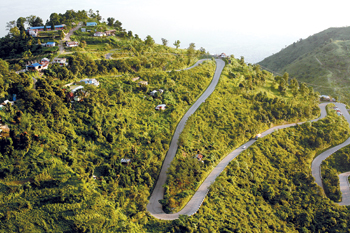Despite professional hazards, local journalists continue to play crucial watchdog role. But at what cost?

ANURAG ACHARYA
DHANKUTA – In the transparent monsoon air the view from the quiet hill station of
Bhedetar is majestic. You can see all the way to Itahari and the wide swathe of the Kosi as it breaks through into the plains.
The scenery provides the perfect backdrop for a group of journalists on a retreat here to review the working conditions and role of the district media in a country where politics seems perennially stuck.
More than 20 journalists from 14 districts had come together under the auspices of the
Centre for Investigative Journalism this week to see how they could apply the skills of in-depth reporting to their setting. But it was clear that the journalists already had vast experience in the practical tricks of the trade they had learnt in the harsh world of rural media.
“I never had any formal training, but I learnt it the hard way, by doing things. Nobody taught me how to report, write or edit news, but I have learned to do all three,” explains Hari Bahadur Lamjel who reports, edits, and publishes Dhankuta Daily.
Lamjel is clear about his sustenance policy and says he makes a living by publishing advertorials and depends on nominal endowment provided by the government to media to cover printing costs. The circulation income barely makes up for administrative costs, he says.
Dhankuta Daily is an example of how most local print newspapers in eastern Nepal with a few hundred hard copy circulation still survive despite the increasing penetration of national dailies, little advertising revenue, and plummeting subscriptions.
Nabina Kharel, a reporter at Purwanchal Dainik who surveyed media companies in Jhapa recently found a woeful lack of professional training for journalists. “Most reporters did not have adequate academic qualification or basic training in news reporting,” she recounts, “but it is also true that local media houses seemed not too keen on hiring qualified journalists or investing in trained staff.”
Manoj Bishwakarma who writes for Fight Daily published from Belbari of Morang quit journalism after finding he could not survive on the income. Bishwakarma returned to journalism after being dissatisfied in his other job, but admits he may quit again if things don’t work out. “You can’t eat job satisfaction,” he told me.
Part of the problem lies with publishers, both local and national, who exploit journalists and use them as marketing agents. “They don’t pay us for months and when we ask for our salary, they tell us to fetch advertisements, increase subscription or recover debts from the market,” a reporter who doubles as an ad collector for a Dhankuta newspaper confided.
Many journalists admitted that they had to moonshine and work on partial contracts for more than one media outlet because the employers were unwilling to hire full-timers and pay them monthly minimum wage prescribed by the government.
At a time when the national media is obsessed with Kathmandu politics, role of regional media in covering local issues has become more crucial. But the costs of working or reporting from remote districts are high and not just financially.
Last year, investigative reporter
Trishna Kunwar was attacked by a criminal gang when she was on an assignment to report illegal logging in community forests in western Nepal. Similarly, a journalist from Panchthar had to request a TV station not to telecast an investigative report about timber smugglers after he was threatened by them.?
In Kathmandu, media watchdogs talk about the need for reporters to exhibit integrity and credibility to do honest and factual reporting. But here on the ground, the hard reality is that reporters are under too much pressure to survive to take extra risks. Little has been done at the policy level by the state and at the professional level by media owners to enhance competence of the reporters, as well as ensure their physical and job security.
Nepal’s grassroots democracy has been dead for 15 years and whatever little accountability exists is largely because of rural radio and community media holding up the tenets of a free press. But their very survival is in question in a fragile media periphery.
Other columns by Anurag Acharya:
Rotten to core
Not everybody's cup of tea
Battle for ballots